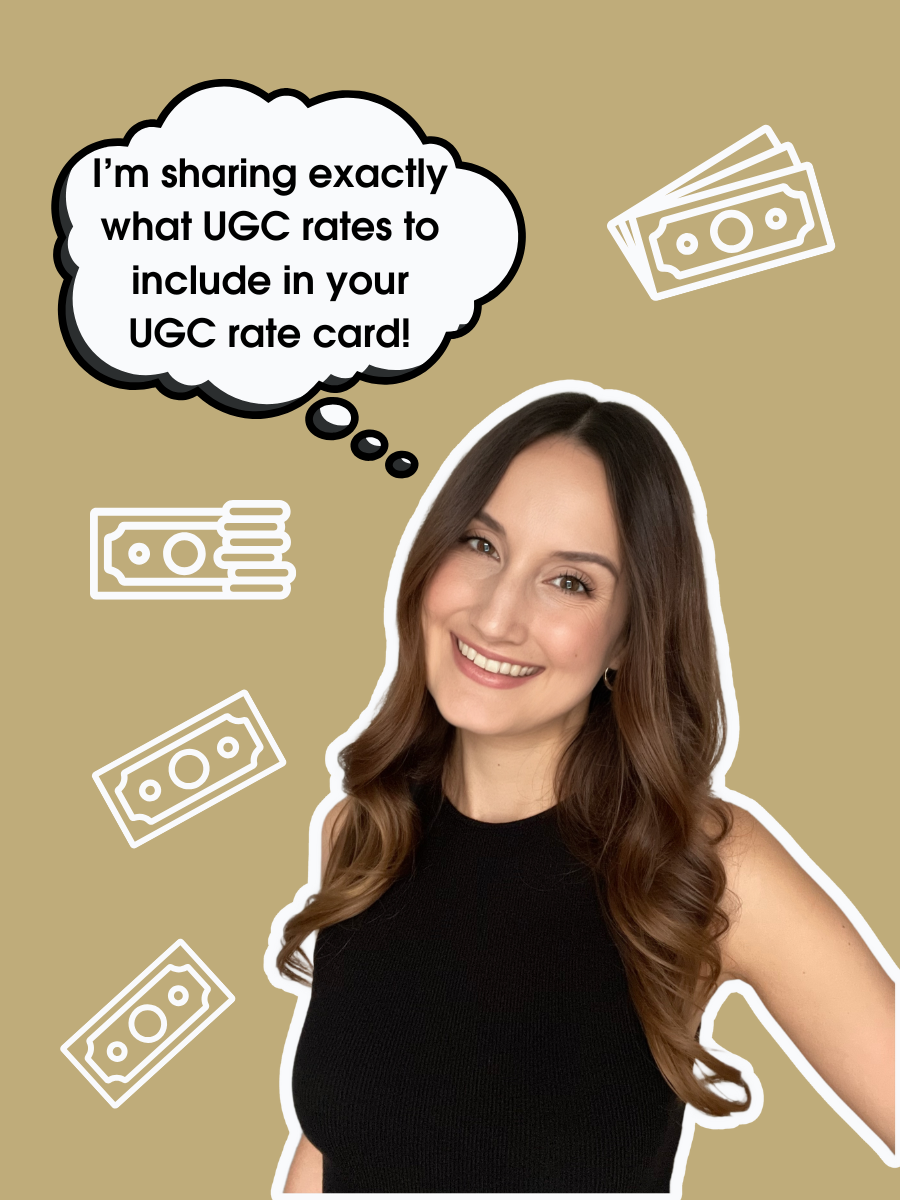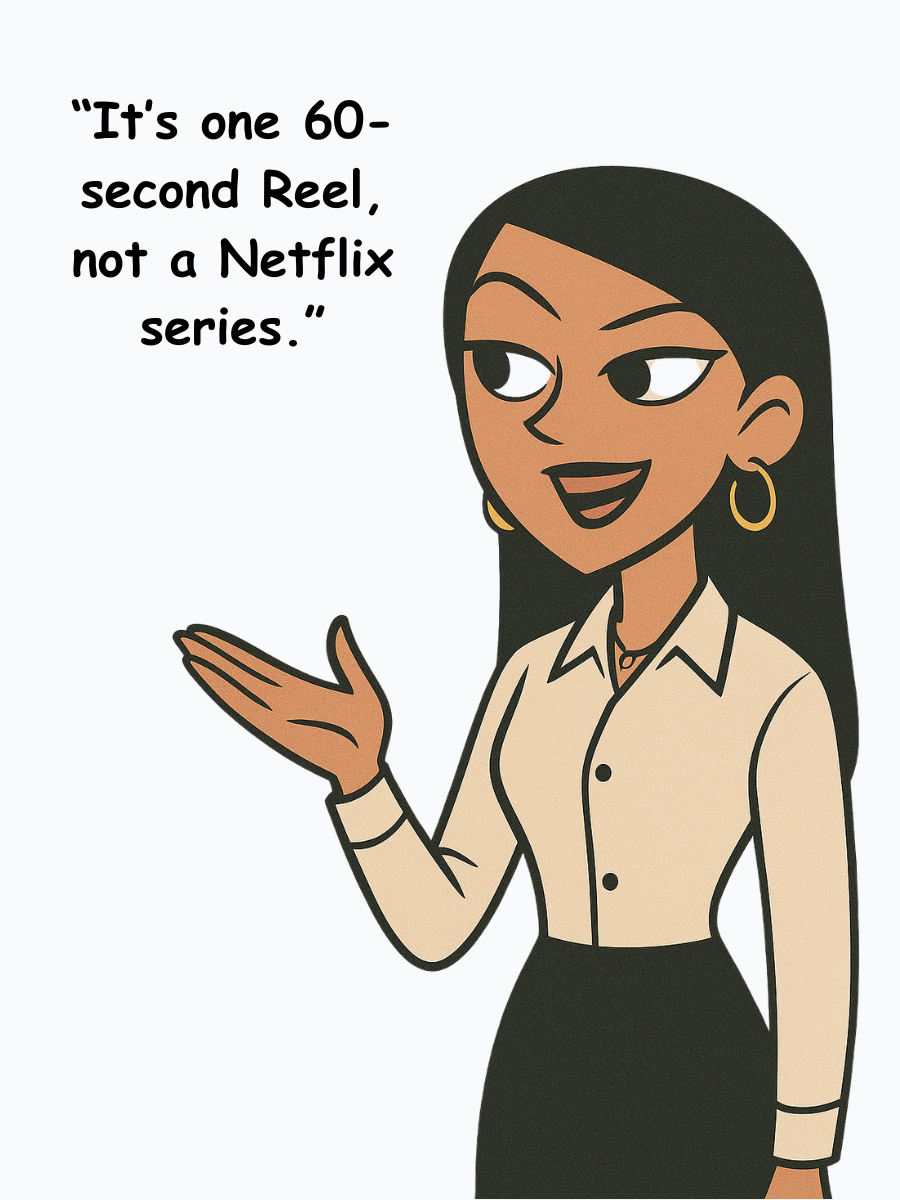The Ultimate UGC Rate Card Guide: What to Include, Pricing Tips + Free Template
Don’t know what to include in your UGC rate card? I’m breaking down all the UGC rates, how to price your UGC services, and gifting you a free UGC rate card template!
If you’re a content creator offering UGC (user-generated content) to brands, you’ve probably seen wildly different prices out there. Some creators charge $100 for a video. Others charge $800. What gives?
The truth is: pricing UGC isn’t just about your filming skills — it’s about the types of UGC rates you charge, how long your content can be used, and what rights you’re licensing. That’s exactly what your UGC rate card and contractneed to clarify.
As a lawyer myself for creators like you (and the creator of a UGC contract template made specifically for UGC creators), I’m sharing everything you need to know to build a smart, professional UGC rate card — including:
What should (and shouldn’t) be included in your base rate
A full breakdown of UGC rates per deliverable
Which usage rights to grant (and how long for)
Why you should never include usage rights “in perpetuity” (even if we’re talking about UGC rates for beginners)
How to use percentage-based add-ons in your UGC rate card template to future-proof your pricing
The ultimate UGC rate card template free of charge that you can start using today
Plus: What your contract must include to protect your content
This blog post will help you understand exactly how to structure your UGC rate card for better-paying, longer-term, and more profitable brand deals.
By the end, you’ll be charging smarter — and earning way more — from your UGC deals!
This post is all about what to include in your UGC rate card to maximize the value of your UGC deals.
Ultimate UGC Rate Card
First Things First: The Base UGC Rates per Deliverable
Before we dive into the different types of UGC rates you should include in your UGC rate card, we must first establish the foundation: your base rate.
Your base rate is the starting rate for your videos and, if you also offer them, photos.
So, the first thing you must do is set a base rate for:
1x Edited UGC Video
1x Edited UGC Photo (if you also offer photography)
This base rate in your UGC card should reflect:
The type of content you’re creating
Your time and skill (including scripting, filming, and editing)
The period of the usage rights granted
And the value your content delivers to the brand
To be clear, you’re not just charging for your time and the value of the content — you’re charging for the right of the brand to use content on their platforms.
What should you base UGC rates per deliverable be?
There’s no “one-size-fits-all,”. UGC is relatively new, so there really is no market standard. Whatever UGC rates other UGC creators include in their UGC rate cards are numbers they pulled out of their you-know-what.
What rate is right for you also very much depends on the type of content you create, in what niche (in general, brands in the finance niche pay more than brand in the beauty industry), and where you live (what’s reasonable in the French countryside may not be reasonable in New York).
So, if anyone is telling you what the “market rate” is or what is “standard.” That’s complete crap.
But if you’re a beginner, you’re probably wondering where to even start. Well, in that case, good base UGC rates for beginners might be:
1x Edited Video (up to 60 sec): $100–$150 (USD)
1x Edited Photo: $40–$75
Keep in mind:
These base UGC rates per deliverable are based on 3 months of organic usage rights only
If you’re offering paid ad usage, that’s a separate fee or bundle (we’ll cover that later).
These rates are ballpark rates if you’re just starting out.
As you gain more experience and improve your production quality, you can (and should) raise your base rates in your UGC rate card.
We’ll discuss what’s included in your base rate next, but first, we need to establish base rates for your packages.
Let’s get into offering why creators offer 1x, 3x, and 5x packages in their UGC rate card.
You’ve probably noticed that usually a UGC rate card will include base rates for three different tiers:
1 video
3 videos
5 videos
These are numbers that make the most sense for brands because they are based on how brands test and use content:
1x Video: A single test post or one-off campaign
3x Video Bundle: For A/B testing different hooks, CTAs, or messages
5x Video Bundle: For batch content (e.g., one month’s worth of posts or multi-platform distribution)
Each tier offers a slight discount (without underpricing your time), making the bundles attractive to brands without devaluing your content.
Here’s what they might like in your UGC rate card if you’re a beginner:
1x Edited Video: $150
3x Edited Video: $400
5x Edited Video: $650
Again, these are just ballpark figures, and you might offer a higher discount, but these tiers provide a higher total payout while helping the brand generate more content from a single shoot — a win-win.
Now, let’s get into what to include in the description of your base rates in your UGC rate card:
Format & length → So, the brand does not expect you to deliver 10 different versions of a video. If they want more, they pay for more!
In case of videos that could be “One vertical video (up to 60 seconds) formatted for TikTok or Reels”
In case of photos that could be “One edited photo formatted for use on [Instagram].”
Number of hooks/CTAs/concepts → So, the brand can’t expect 5 different hooks per video. If the brand wants additional hooks, they pay for that add-on!
In case of a video, you could state “Includes 1 unique hook or CTA.”
For a photo, you could state, “Includes 1 concept.”
Revisions → This is extremely important because otherwise, you could end up in endless revision rounds without the brand paying you for that extra time and energy. So state the number of minor revisions that are included in the base price. That could be only 1 revision round or 2. And the keyword here is minor — to avoid full reshoots. “Includes one round of minor revisions.”
Usage rights → Another component that can’t be overlooked is the usage rights included in the base UGC rates per deliverable. Usually, UGC creators include 3 to 6 months of usage rights in their UGC rates. However, they often do not specify that these are organic usage rights, and thus, no paid usage rights are included (for which a higher rate should apply). I also like to take it a step further and specify that it only includes organic use on up to 2 platforms (more on this in the next section).
What Not to Include in Your BASE UGC Rates per Deliverable
Here’s what you should not include in your base rates (and clarify in your UGC rate card):
❌ Unlimited platforms (limit to 2 unless paid for)
❌ Unlimited usage duration (stick to 3 months unless licensed longer)
❌ Raw footage
❌ Extra versions or hooks
❌ Full usage rights or perpetual rights (unless offered as an add-on)
You should always charge extra for extra services and deliverables — don’t give away extras for free by accident!
My UGC Rate Card Example
In my free UGC rate card template, you can describe exactly what is included in each deliverable:
1x Edited Video → “One edited [vertical] video (up to [60] seconds) formatted for use on [TikTok or Reels]. Includes [1] unique script with [1] hook/CTA.”
1x Edited Photo → “One edited photo formatted for use on [Instagram]. Includes [1] concept.”
Below all the base UGC rates per deliverable, I’ll have a clear description in bullet points of what’s included:
“The above base rates for ‘Organic Use’ include organic use on a maximum of [[2] social media platforms].
The above base rates for ‘Paid Use’ include ad use on [social media platforms] only.
[1] round of minor revisions is included per deliverable stated above.
A standard delivery period of up to [7] days applies.
Additional versions, hooks, or CTAs are charged separately.
Each deliverable includes a [3] months of organic/paid usage rights (outlined below).
Extensions and upgrades are available via add-ons below.”
What Usage Rights to Include in UGC Rates for Beginners and Seasoned Creators
Including limits on usage rights in your UGC rate card is not optional — it’s where most UGC creators, especially beginners, either undervalue their content or get taken advantage of.
When you’re granting usage rights to a brand, you’re permitting them to use that content for a specific purpose, in a specific place, for a specific amount of time.
If you don’t clearly define those rights in your UGC rate card and contract, the brand may assume they can do whatever they want with your content forever. And that’s how your unpaid ad ends up on Facebook for two years straight.
Let’s break down the three most common types of usage rights:
1. Organic Usage Rights
Organic usage means the brand can post your content on their own platforms without putting ad dollars behind it.
For example, posting your UGC to their Instagram feed or TikTok account.
In your base rate, I recommend limiting this to:
3 months of use
Up to 2 social media platforms
If the brand wants to post your video on their Instagram and YouTube Shorts, and also use it in email marketing? Use in emails should be charged as an add-on.
And, if they want to use the UGC for longer than those 3 months, then you should charge them on a monthly basis for each additional month.
That’s how you really start to earn passively.
2. Paid Ad Usage Rights
Paid usage rights enable the brand to use your UGC in paid advertising campaigns, including Meta (Facebook/Instagram) Ads, TikTok Ads, YouTube Ads, Google Ads, and Pinterest Ads, among others.
Paid usage gives brands a much higher return, which means you should charge more for it.
Because many brands will want to use your UGC for paid ads, I recommend including separate base rates for paid usage in your UGC rate card.
3. Full Usage Rights
This is when a brand wants to use your content everywhere — organically and in paid ads, across all platforms, and possibly in emails, websites, landing pages, in-store displays, and more.
For full usage rights, you should charge a separate higher fee, as the brand gets full freedom to use the content anywhere.
But please note that full usage rights are NOT the same as perpetual rights. Many UGC creators use these terms interchangeably, but these should be kept separate.
You can grant full usage rights, but always time-limit them.
In my UGC rate card template, full usage rights are offered as an add-on and priced monthly.
Why You Should Never Include Usage Rights “In Perpetuity”
You might’ve seen some creators list “perpetual rights” in their rate cards — usually without understanding what it actually means.
If a brand runs your content for years, uses it in ad campaigns that generate $100K in sales, and you only get paid once? That’s the risk of perpetual use.
Perpetual use = unlimited time, unlimited platforms, unlimited exposure — for a one-time payment.
As a lawyer, I strongly advise against offering perpetual rights in your UGC rate card.
Want to know why perpetual rights are risky? I break it all down in this blog post: What “Usage Rights in Perpetuity” Really Means (+ Why It Matters for Creators).
Packages & Add-Ons to Include in a UGC Rate Card Free of Fluff
Now, you know what the base UGC rate per deliverable is to include in your UGC rate card.
Now, let’s get into all the other UGC rates you must have in your UGC rate card.
A/B Testing Packages
What it is: A set of videos with different hooks, CTAs, or intros for testing what converts best in ads or posts.
Why charge for it: Brands will usually want multiple versions to test, but it takes you extra time to script, film, and edit each one.
Pro tip: Offer this as a 3x or 5x video bundle (with a small discount built in), and clarify that each video includes a different hook or message.
Custom Packages
What it is: Many UGC creators also offer custom packages (at a discounted rate) based on what brands usually want (e.g., 2 photos + 2 videos, or monthly batches).
Why charge for it: Some brands may come to you for 3 Reels, but may be interested in two additional Stories. You can entice them to spend a little more to get a little more from you.
Additional Organic Platforms
What it is: When a brand wants to use your content on more than 2 social platforms (e.g., TikTok, IG, Pinterest, YouTube, LinkedIn, etc.).
Why charge for it: More visibility = more value. If your content is used across multiple channels, the brand benefits more, and you should too.
Extended Organic Use
What it is: Extending how long a brand can use your content organically (e.g., from 3 to 6 months).
Why charge for it: If they want to keep using your content past the agreed period, they should renew the license just like any other media license.
Extended Paid Use
What it is: Extending the period your content can be used in paid ads (beyond the standard 3-month license).
Why charge for it: Paid ads generate direct revenue for brands. Longer use = more ROI for them, so you deserve recurring value.
Full Usage Rights
What it is: Content can be used across all platforms — paid and organic, including social, website, email, and more.
Why charge for it: This gives brands the most flexibility and value, so it should come at a premium.
Reminder: This does not include usage in perpetuity!
Raw Footage
What it is: The original, unedited video files.
Why charge for it: Raw files can be repurposed and edited by the brand into multiple ads or clips — that’s more content value than a finished product.
Extra Hook or CTA
What it is: A second intro, message, or call-to-action (e.g., “Buy now” vs. “Learn more”).
Why charge for it: More hooks = more scripting, more filming time, more editing.
Rush Delivery
What it is: Delivering the content faster than your standard turnaround time (e.g., 48 hours vs. 5–7 business days).
Why charge for it: You’re prioritizing their content and possibly rescheduling other projects. That’s premium service.
Additional Revisions
What it is: More revision rounds beyond the 1 round typically included.
Why charge for it: Revisions consume time, especially when they involve more than minor tweaks.
How to Price Your UGC Add-Ons in Your UGC Rate Card Template
Now that you know what to charge for, let’s talk about how to charge for it, without redoing your rate card every time you raise your base rates.
The easiest solution? Use percentages.
Instead of listing a fixed price for each add-on, add a % to your base rate. That way, your pricing automatically scales with your rates, and you won’t have to update your whole UGC rate card every time you raise your prices (which you should do as you grow!).
Here’s a quick example:
Raw Footage: +30% of the base video rate
Full Usage Rights: +75%
Rush Delivery: +50%
Extra Hook/CTA: +15%
Please note that these are just example percentages. Every creator charges differently based on their content, time, niche, and experience.
As I said earlier, there’s no market standard for UGC rates and how they are charged. Everyone’s just spouting out numbers without any real foundation. Start with what feels fair to you, and adjust based on demand.
Want a full breakdown of pricing strategies and percentage-based add-ons? I’ll cover all of that in a separate post — stay tuned!
The Ultimate UGC Rate Card Template Free of Charge
Now that you know what to include (and what not to include) in your UGC rates — you’re ready to build a rate card that looks professional, protects your value, and actually gets you paid fairly.
I’ve created a free UGC Rate Card Template you can customize in Canva — designed with:
Editable [price] placeholders so that you can set your own rates
Clear, professional descriptions for each deliverable
Built-in boundaries: usage limits, revision caps, delivery timelines
A separate add-ons section with percentage-based pricing
No fluff: no “About Me” section or content type lists — just the facts brands need to make a decision
All you need to do is subscribe to my newsletter below (don’t worry, I’ll only email you once a month at most with updates and more free stuff).
Beyond the UGC Rate Card — Your UGC Contract
Your rate card sets expectations, but it is not (or at least shouldn’t be used as) a legally binding contract.
You need to use a formal UGC contract that actually protects your time and content, secures your payment, and protects you against liability risks. It also sets your boundaries for your deliverables (because yes — brands will push boundaries if you don’t set them.)
Here’s what every UGC contract should define:
My UGC Creator Contract Template is specifically designed for creators like you — and it’s already helped hundreds of creators protect their content, pricing, and peace of mind.
Learn more about my UGC Contract Template here!
This post was all about what to include in your UGC rate card to maximize your UGC deals.
Wondering what you should charge brands as an influencer? Read these blog posts next:





